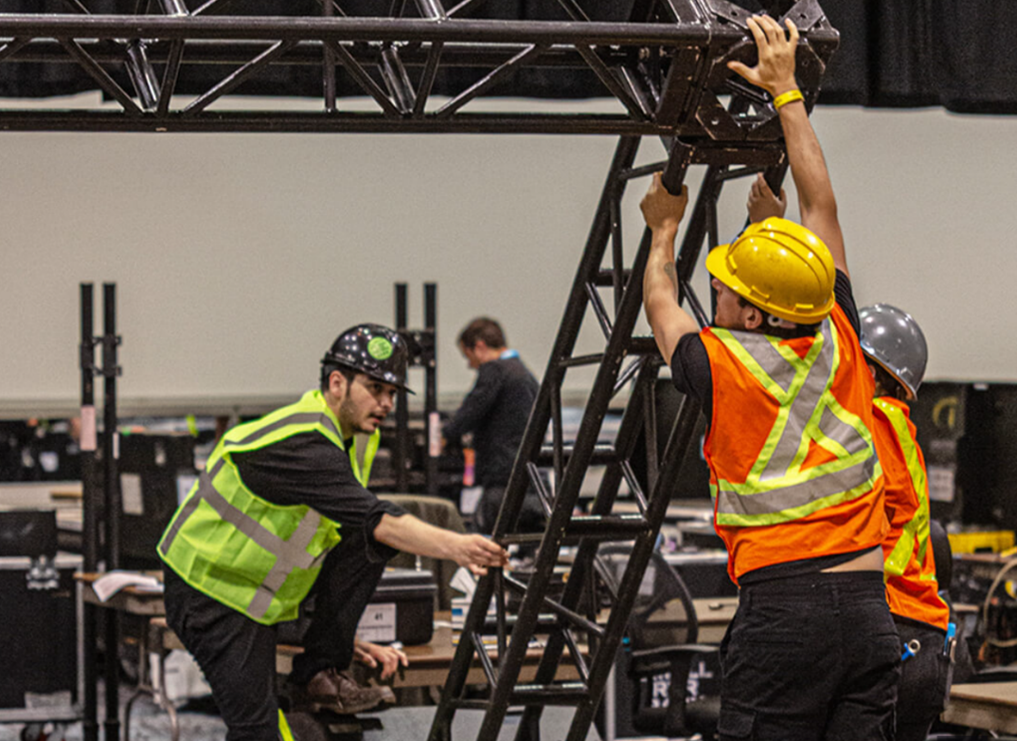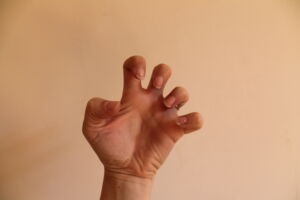Safe Lifting at Work
Preventing Musculoskeletal Disorders
Setting up and taking down events requires lifting equipment and other items, and at times lifting heavy and awkward objects (e.g., set pieces, décor, truss, projectors). These activities increase the risk of Musculoskeletal Disorders (MSDs), including strains and sprains and other injuries, especially to the lower back.
According to the Canadian Centre for Occupational Health and Safety (CCOHS), lifting is the most common cause of lower back pain in Canadian workplaces. Since lifting is a common task on our job sites, preparing and planning for the lift and practicing safe lifting and handling techniques are crucial to reduce the likelihood and severity of injuries.
Before you lift, PLAN AHEAD! Know what you are lifting and how you will lift it.
Safe Lifting Techniques
Stacking and Unstacking Cases
Stacking and unstacking cases with a partner or in a team can reduce the chance of injury with clear communication and by following these steps:
- Make sure all parties involved are clear on the task at hand by discussing things like which side of the stack you will be dropping the case on.
- Be sure everyone is comfortable with the task and that the lift can be done without over-exertion.
- Make sure the area you are working in is clear of debris on the ground, the ground is level and that you have ample room to carry out the task.
- Keep eye contact with the crew member you are lifting with, counting down to ensure any lifting is done in sync.
- When possible, use the lift gate of the truck to stack cases.
Solo LIfting
When lifting cases or other objects on your own, follow these safety procedures:
- If the case/item is too heavy to lift comfortably on your own, get help from someone else or use the assistance of a lifting device,
- Test the load to ensure you can lift it on your own,
- Widen your stance with your dominant foot slightly forward,
- Lift with your legs and a straightened back,
- Keep your head up and look forward while you lift,
- Keep the load close to your body and keep your back straight, and
- Keep your behind out to balance the load while you lift.

Forklift Safety
On some setups and dismantles, road cases can be too heavy for an individual or a team to stack or unstack safely. In this instance, stacking or unstacking cases will require the use of a forklift. While a forklift can make the job easier, there are safety risks if proper protocols are not followed when working with a forklift and the forklift operator.
When stacking or unstacking cases with your fellow crew members, it is important to:
- Appoint one person in the group to communicate with the forklift operator.
- Maintain eye contact with the forklift operator to ensure you are both working in sync.
- Clearly communicate with the forklift operator when and how you would like them to move the forks (use terms like ‘stop’, ‘all clear’, and ‘forward’ or ‘backward’)
- Keep your hands and body away from any cases or loads that are on the forks and in the air.
- When a case is being stacked on another case, there are times when the castors need to be adjusted so they are sitting properly in the wheel wells. When resetting the castors, be extra careful that you keep your hands away from any pinch points.
- If working in an area with low visibility or at night, ensure you are wearing a high-visibility vest.
Handing Gear to a Crew Member on a Ladder
Passing gear up to a crew member on a ladder is a common occurrence on site. This can include passing up video panels, lights or tools.
It is important for both parties to communicate while the piece of equipment is exchanging hands. This also includes keeping an eye out for the crew member who is on the ladder, reminding them to ensure they are maintaining 3 points of contact with the ladder at all times. If you are the crew member on the ground, it is important to wear your hard hat to protect yourself and prevent injuries from any gear or tools that may fall while in the process of completing this task.
Team Lifting of Truss Structures

Prior to lifting a truss structure by hand, the crew should first discuss the safest way to lift the structure and how many people will be needed based on the size and weight of the structure. Make sure everyone is on the same page and assign one crew member to call the lift and a second crew member to foot the base plate by keeping constant pressure on the plate in a downward force.
Lifting Gear in a Truck
Occasionally when packing up an event, we run into the issue of there being too many cases and not enough truck! So, sometimes we have to get creative on how we pack the gear.
Some cases are small and easy to stack up on top of other cases that have already been strapped in; a process known as top loading. If lifting cases over your head, be mindful of where you place your hands. It’s easy to get your hand or arm caught in a pinch point if you’re not being careful. For cases that are heavy, big, or awkward, take a moment to plan the route or landing spot before lifting the case.
ACTION REQUIRED
Practicing safe lifting techniques will aid in the prevention of musculoskeletal disorders, especially injuries to your lower back. Before you lift, always remember to do the following:
- STRETCH before beginning work and on breaks as well as before a heavy lift. It’s important to prepare your body for work to improve performance and reduce the risk of injury. Scroll down to read our special addition on “Stretching Techniques”.
- CHECK YOUR PATHWAY. Make sure the work area is flat, dry and clear of debris.
- PLAN AHEAD AND COMMUNICATE.
-
- Be aware of the weight of the object.
- Determine whether the object is safe to lift on your own. Always seek assistance if you are unsure of your ability to pick up an item.
- Identify when team-lifting is required for large, heavy, or awkward items.
- Plan your actions before getting started and point out any hazards that may impede your progress to ensure the task can be completed safely. Remember, taking a few minutes to talk about the task can avoid injuries and damage to equipment.
- Communicate clearly with others when lifting together, moving truss etc. (example: “moving”, “got it”, “case coming in” etc.)
- Stay alert while carrying out the task by checking in periodically with other crew members, establishing eye contact with anyone in moving vehicles and while lifting with a colleague.
- Always remember to lift on 3!
- LIFT WITH YOUR LEGS, NOT YOUR BACK. Avoid awkward positions and always lift with the legs, not the back; the back is very susceptible to injury in a bent position.
Stretching Techniques
 Sr. Crew Lead and Joint Health and Safety Committee (JHSC) member, Kate Rowlands who is also a certified yoga instructor, has prepared this special addition to this month’s blog, providing guidance for creating good habits and preventing musculoskeletal disorders.
Sr. Crew Lead and Joint Health and Safety Committee (JHSC) member, Kate Rowlands who is also a certified yoga instructor, has prepared this special addition to this month’s blog, providing guidance for creating good habits and preventing musculoskeletal disorders.
Our job becomes repetitive and can cause bad habits in our bodies, so here’s a few tips to stretch out and get the body ready for work, as well as for building good habits in your body on the job.
First and foremost, the most important tool for a good stretch is your breath, every inhale and exhale you’re trying to breathe slower and slower. Inhales are used to find length and to realign your posture, exhales are used to go deeper into the stretch.
RAGDOLL

The lazy man’s standing forward fold. Bend those knees, round your spine, get as comfortable as you can in this position, posture be damned! Then what I really like to do is loosen all the neck muscles and shake my head vigorously side to side. I get a good few cracks out when I do this during a nice long exhale, but that’s just me. Shaking your head side to side is not always comfortable for everyone so if that doesn’t sound relaxing to you remaining stationary is fine too!
Without straining, use each inhale to feel like your spine is getting straighter (let your torso lift up if that helps) and each exhale feeling space growing between your vertebrae. Your head and arms want to feel floppy and heavy. You might even get a crack down your spine! (I like to do this on a break when most people are out of the room, and I’ll find a road case crowded corner or somewhere more private. Pro tip for those who don’t love the idea of bending over at work lol)
NECK MOVEMENTS
We’ve got the classic neck roll, rolling the head back and forth across the chest. Pro tip! If you notice an especially tight spot, you can hold your head there for a full breath or two before returning to rolling. Another good one is sitting or standing up straight and turning your head side to side, keeping it slow, really trying to turn a little bit further every time, using a long exhale to do so. And if it’s really stiff, you can add on to that: when you turn your head to one side, lift your chin as high as is possible to sustain, take a full breathe there, and then reverse back out.
SEATED TWIST
Sit on one of the hundreds of banquet chairs most likely surrounding you right now, or on a road case. Find a straight spine, inhale to find length, exhale, draw the belly button to the spine and feel the twist coming through the upper body.
WRIST/ARM/SHOULDER MOVEMENTS
Shake and roll out the wrists often. I also really like stretching open the fingers and then curling in the fingers (not like a fist, like a paw lol)


If your forearm is feeling tight you can pull back on your hand, bring your wrist to a 90-degree angle, and use your breath to feel the stretch up the forearm.
Shoulder rolls to open up the chest feels good after you’ve been hunched on the ground for too long, and pro tip for working outside in the cold! With your arms at your side and your fingers actively outstretched, shrugging your shoulders up and then shooting them down quickly will cause blood to rush into the finger tips and will help warm them up!
STRETCH/MOVEMENT VIDEO
Quick Video Recap on Stretching at Work
FURTHER INFORMATION
Canadian Centre for Occupational Health and Safety (CCOHS): How to Lift Safely (Poster)
Healthline: 7 Lower Back Stretches to Reduce Pain and Improve Mobility

This Health and Safety Snapshot was brought to you by Cavan Sladen, Crew Chief and Certified JHSC Worker Representative at Crew Supply Inc. Cavan has extensive experience supervising large crews and is Crew Supply’s key person for workplace and safety inspections. He has a passion for health and safety and serves as Co-chair on Crew Supply’s Joint Health and Safety Committee.




